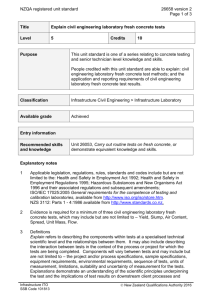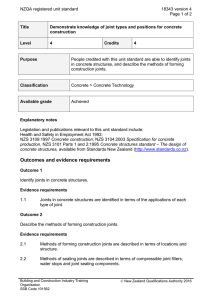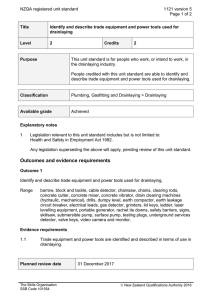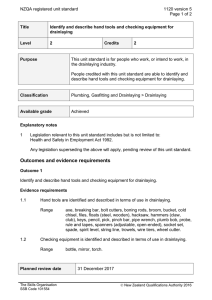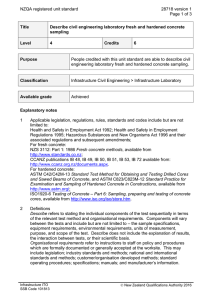NZQA registered unit standard 18347 version 4 Page 1 of 3
advertisement
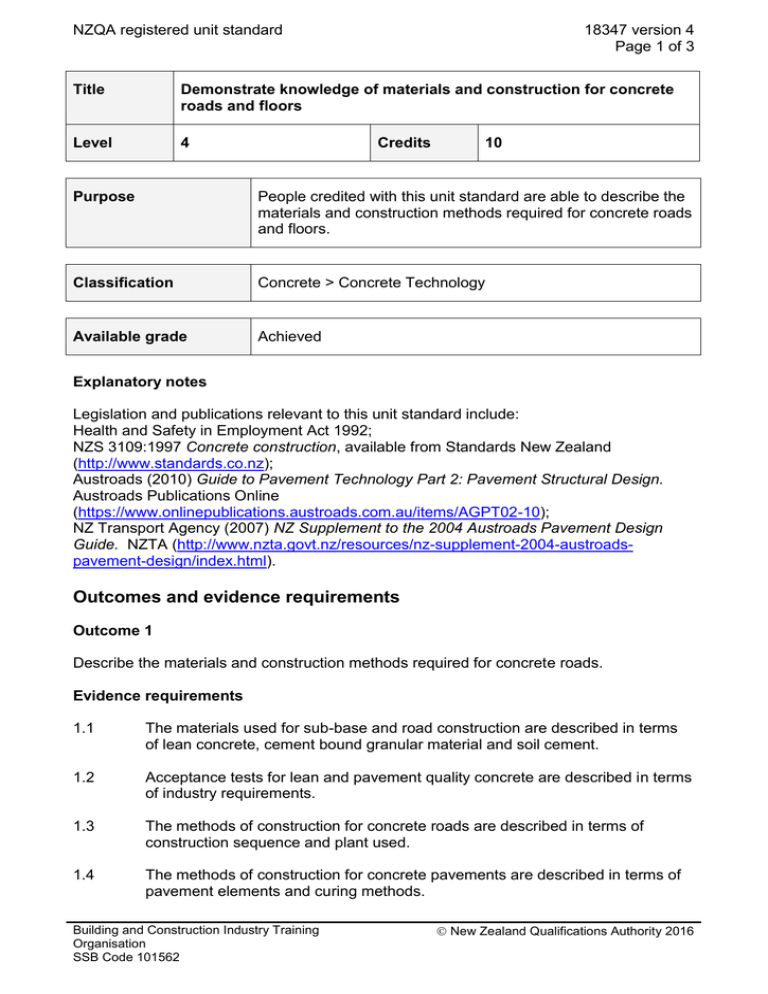
NZQA registered unit standard 18347 version 4 Page 1 of 3 Title Demonstrate knowledge of materials and construction for concrete roads and floors Level 4 Credits 10 Purpose People credited with this unit standard are able to describe the materials and construction methods required for concrete roads and floors. Classification Concrete > Concrete Technology Available grade Achieved Explanatory notes Legislation and publications relevant to this unit standard include: Health and Safety in Employment Act 1992; NZS 3109:1997 Concrete construction, available from Standards New Zealand (http://www.standards.co.nz); Austroads (2010) Guide to Pavement Technology Part 2: Pavement Structural Design. Austroads Publications Online (https://www.onlinepublications.austroads.com.au/items/AGPT02-10); NZ Transport Agency (2007) NZ Supplement to the 2004 Austroads Pavement Design Guide. NZTA (http://www.nzta.govt.nz/resources/nz-supplement-2004-austroadspavement-design/index.html). Outcomes and evidence requirements Outcome 1 Describe the materials and construction methods required for concrete roads. Evidence requirements 1.1 The materials used for sub-base and road construction are described in terms of lean concrete, cement bound granular material and soil cement. 1.2 Acceptance tests for lean and pavement quality concrete are described in terms of industry requirements. 1.3 The methods of construction for concrete roads are described in terms of construction sequence and plant used. 1.4 The methods of construction for concrete pavements are described in terms of pavement elements and curing methods. Building and Construction Industry Training Organisation SSB Code 101562 New Zealand Qualifications Authority 2016 NZQA registered unit standard 1.5 18347 version 4 Page 2 of 3 Joints and joint assemblies for concrete roadwork are explained in terms of industry requirements. Outcome 2 Describe the materials and construction methods required for concrete floors. Evidence requirements 2.1 The methods used for the construction and finishing of concrete floor slabs are described in terms of flatness and levelness. 2.2 Joints used in ground floor slabs are explained in terms of industry requirements. 2.3 Methods of designing, finishing and curing floor slabs are described in terms of design for loading and life, durability, surface regularity, and joint design and bag layout. 2.4 Granolithic and high strength toppings are described in terms of their uses, possible causes of failures and precautions taken to minimise failures. 2.5 Application of surface treatments are described in terms of resistance to abrasion and dusting, and non-slip features. 2.6 Screeds are described in terms of their uses. 2.7 Methods of construction and finishing of screeds are described in terms of their mix proportions, possible causes of failure and precautions which can be taken to reduce them. Planned review date 31 December 2013 Status information and last date for assessment for superseded versions Process Version Date Last Date for Assessment Registration 1 23 May 2001 N/A Revision 2 16 July 2004 N/A Rollover and Revision 3 25 January 2008 N/A Rollover and Revision 4 17 November 2011 N/A Consent and Moderation Requirements (CMR) reference 0048 This CMR can be accessed at http://www.nzqa.govt.nz/framework/search/index.do. Building and Construction Industry Training Organisation SSB Code 101562 New Zealand Qualifications Authority 2016 NZQA registered unit standard 18347 version 4 Page 3 of 3 Please note Providers must be granted consent to assess against standards (accredited) by NZQA, before they can report credits from assessment against unit standards or deliver courses of study leading to that assessment. Industry Training Organisations must be granted consent to assess against standards by NZQA before they can register credits from assessment against unit standards. Providers and Industry Training Organisations, which have been granted consent and which are assessing against unit standards must engage with the moderation system that applies to those standards. Requirements for consent to assess and an outline of the moderation system that applies to this standard are outlined in the Consent and Moderation Requirements (CMR). The CMR also includes useful information about special requirements for organisations wishing to develop education and training programmes, such as minimum qualifications for tutors and assessors, and special resource requirements. Comments on this unit standard Please contact the Building and Construction Industry Training Organisation national.office@bcito.org.nz if you wish to suggest changes to the content of this unit standard. Building and Construction Industry Training Organisation SSB Code 101562 New Zealand Qualifications Authority 2016
